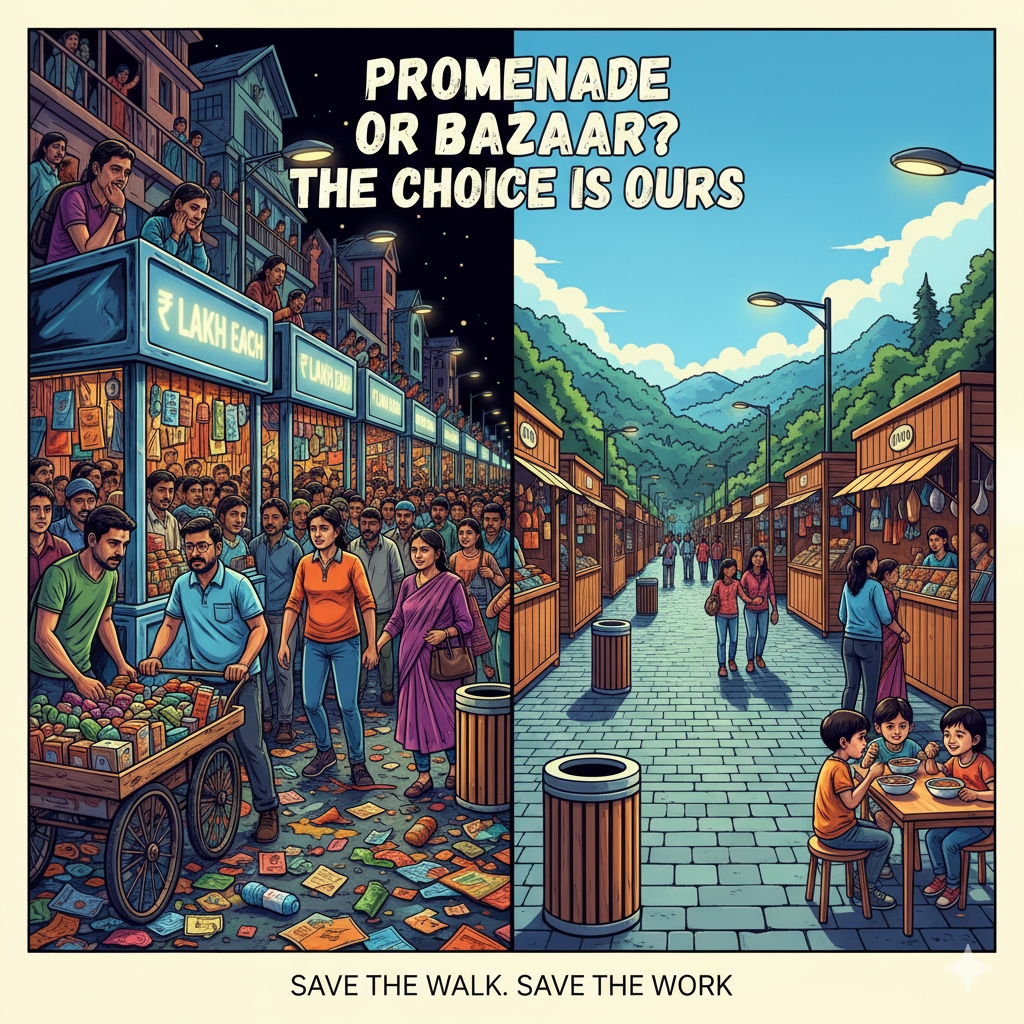
Mussoorie’s Mall Road: Promenade, Bazaar, or Political Battleground?
Vendors, Votes & the Future of Mall Road
Few issues have split Mussoorie so sharply — and united so many unlikely political actors — as the question of hawkers and patri vendors on Mall Road. What was once a narrow civic dispute has now ballooned into a full-fledged political battlefield stretching from the Nagar Palika office to Bhagat Singh Chowk, from local wards to the state capital.
The Local Turf War
It began with the eviction of vendors from Mall Road three months ago, when Palika under Chairperson Meera Saklani promised to create vending zones within 15 days. Nothing concrete emerged. Out of desperation, vendors began creeping back onto the Mall — triggering confrontation with Palika staff.
This was the cue for political actors to take sides. Geeta Kumai (councilor), along with former chairpersons Anuj Gupta and Manmohan Singh Malla, threw their weight behind the vendors, calling the Palika’s inaction unjust. They proposed vending arrangements even inside the Mall, or a flea market style model, in the name of livelihoods.
Saklani struck back hard. She accused Gupta of past corruption — leasing Palika properties for 25–30 years at throwaway prices, almost handing over even the Town Hall. She also questioned Kumai’s silence during Gupta’s term. Her message was sharp: today’s chaos is yesterday’s legacy.
The Residents’ Outcry
In the middle of this tug-of-war stand Mussoorie’s residents, hoteliers, and heritage lovers. For them, Mall Road is not a bazaar but a promenade — one of the finest in the world. They fear that if kiosks worth lakhs are allowed to sprout along the Mall, Mussoorie will lose its only USP: a clean walk with mountain air.
Their voices demand a balance:
--Keep Mall Road free of stalls.
--Create an alternate flea market or vending complex — perhaps on Palika land, Company Garden, or George Everest side.
--Ensure only genuine, needy vendors get certificates — not families with houses, cars, and multiple incomes.
The refrain is clear: Save the Walk. Save the Work.
The State-Level Entry
Just when the debate seemed limited to municipal turf, former CM Harish Rawat entered the fray on Bhagat Singh Jayanti at Bhagat Singh Chowk. Surrounded by slogans of “Inquilab Zindabad,” Rawat demanded that vendors be allowed back on the Mall within 15 days — or Congress would hit the streets.
His move reframed vendors as symbols of injustice, aligning their plight with farmers, labourers, and rickshaw pullers. In one stroke, what began as a Palika issue became fodder for state-level politics, with vendors positioned as a vote bank worth fighting over ahead of 2027.
Heritage, Livelihood, Politics
At heart, this is not just about a few momo stalls or trinket sellers. It is about:
Heritage: Can Mussoorie preserve the Mall as a promenade, not a marketplace?
Livelihood: Can small traders and hawkers be given dignity and income in a structured space?
Politics: Can leaders resist turning vendors into pawns of vote-bank arithmetic?
Right now, each camp has staked its claim:
Meera Saklani: Vendors caused chaos; only eligible ones will be regularised.
Anuj Gupta, Geeta Kumai, Manmohan Singh Malla: Vendors are victims; Palika failed them.
Residents & Hoteliers: Mall must be saved; create a flea market outside.
Harish Rawat & Congress: Vendors = vote bank + moral cause; BJP = anti-poor.
The Way Forward
The only lasting solution is a transparent Vendor Policy:
A proper flea market / vending zone outside Mall Road.
Uniform kiosks, water & sanitation, eco-friendly waste management.
Genuine vetting — asset declarations to stop profiteering.
Mall Road reserved as a heritage promenade.
Mussoorie does not need more blame games. It needs vision. Because in the end, the vendors are not just selling momos or trinkets — they are selling the credibility of Mussoorie itself.
